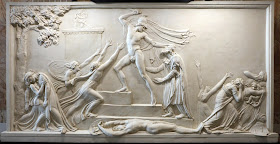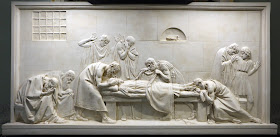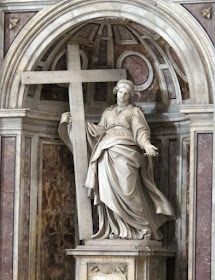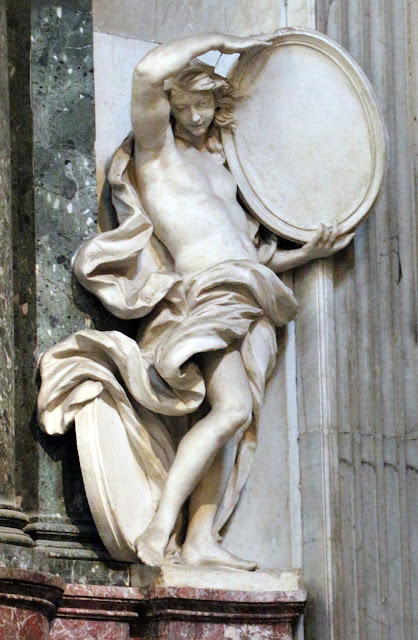 |
| Giuseppe Torretti Bust of Democritus 1705 marble Museo del Settecento Veneziano, Ca' Rezzonico, Venice |
Once more, Democritus, arise on earth,
With cheerful wisdom and instructive mirth . . .
Attentive truth and nature to descry,
And pierce each scene with philosophic eye.
To thee were solemn toys or empty show,
The robes of pleasure and the veils of woe:
All aid the farce, and all thy mirth maintain,
Whose joys are causeless, or whose griefs are vain . . .
Unnumbered suppliants crowd preferment's gate,
Athirst for wealth, and burning to be great;
Delusive fortune hears th' incessant call,
They mount, they shine, evaporate, and fall.
– Samuel Johnson, from The Vanity of Human Wishes (1749)
 |
| Bernardino Cametti Diana the Huntress ca. 1717-20 marble Bode Museum, Berlin |
 |
| Giovanni Battista Foggini Posthumous Bust of Galileo Galilei (tomb sculpture) ca. 1722-25 marble Basilica di Santa Croce, Florence |
 |
| Antonio Corradini Adonis ca. 1723-25 marble Metropolitan Museum of Art, New York |
 |
| Antonio Corradini Personification of Honor ca. 1730 marble Bode Museum, Berlin |
 |
| Antonio Corradini Personification of Wealth ca. 1730 marble Bode Museum, Berlin |
 |
| Girolamo Ticciati Salome before Herod with the Head of John the Baptist ca. 1732 marble relief Museo dell' Opera del Duomo, Florence |
 |
| Innocenzo Spinazzi Personification of Faith 1781 marble Chiesa di Santa Maria Maddalena de' Pazzi, Florence |
 |
| Antonio Canova Dance of the Sons of Alcinous ca. 1790-92 marble relief Gallerie di Piazza Scala, Milan |
 |
| Antonio Canova Dance of the Sons of Alcinous (detail) ca. 1790-92 marble relief Gallerie di Piazza Scala, Milan |
 |
| Antonio Canova Briseis taken from Achilles and conveyed to Agamemnon ca. 1787-90 marble relief Gallerie di Piazza Scala, Milan |
"The Iliad was published volume by volume, as the translation [by Alexander Pope] proceeded: the four first books appeared in 1715. The expectation of this work was undoubtedly high, and every man who had connected his name with criticism, or poetry, was desirous of such intelligence as might enable him to talk upon the popular topic. Halifax [Charles Montagu, first Earl of Halifax], who, by having been first a poet, and then a patron of poetry, had acquired the right of being a judge, was willing to hear some books while they were yet unpublished. Of this rehearsal Pope afterwards gave the following account:
The famous Lord Halifax was rather a pretender to taste than really possessed of it. When I had finished the two or three first books of my translation of the Iliad, that Lord desired to have the pleasure of hearing them read at his house. Addison, Congreve, and Garth, were there at the reading. In four or five places Lord Halifax stopped me very civilly, and with a speech each time, much of the same kind, "I beg your pardon, Mr. Pope; but there is something in that passage that does not quite please me. Be so good as to mark the place, and consider it a little at your leisure. I'm sure you can give it a little turn." I returned from Lord Halifax's with Dr. Garth, in his chariot: and, as we were going along, was saying to the Doctor that my Lord had laid me under a good deal of difficulty by such loose and general observations; that I had been thinking over the passages almost ever since, and could not guess at what it was that offended his Lordship in either of them. Garth laughed heartily at my embarrassment; said, I had not been long enough acquainted with Lord Halifax to know his way yet; that I need not puzzle myself about looking those places over and over, when I got home. "All you need to do (says he) is to leave them just as they are; call on Lord Halifax two or three months hence, thank him for his kind observations on those passages, and then read them to him as altered. I have known him much longer than you have, and will be answerable for the event." I followed his advice; waited on Lord Halifax some time after; said, I hoped he would find his objections to those passages removed; read them to him exactly as they were at first; and his Lordship was extremely pleased with them, and cried out, "Ay, now they are perfectly right: nothing can be better."
– Samuel Johnson, from Lives of the Most Eminent English Poets (1779)
 |
| Antonio Canova Briseis taken from Achilles and conveyed to Agamemnon (detail) ca. 1787-90 marble relief Gallerie di Piazza Scala, Milan |
 |
| Antonio Canova Death of Priam ca. 1787-90 marble relief Gallerie di Piazza Scala, Milan |
 |
| Antonio Canova Death of Priam (detail) ca. 1787-90 marble relief Gallerie di Piazza Scala, Milan |
 |
| Antonio Canova Criton closing the eyes of Socrates ca. 1790-92 marble relief Gallerie di Piazza Scala, Milan |












































